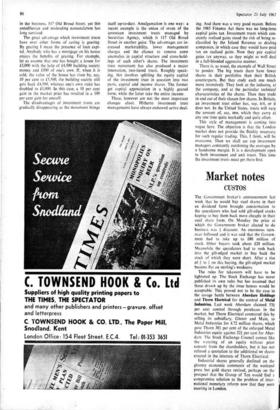New style trusts
JOHN BULL
As the shareholding public has expanded since the war, so have unit trusts and the funds em- ployed in with-profits life policies. Yet invest- ment trusts, an equally satisfactory method of participating in equities, have been largely neglected, It is a pity: investment trusts have long-established and highly expert manage- ments, whereas many unit trust managements are too new to have shown any sort of form at all. Investment trusts are closed portfolios. Selling or buying shares in such trusts neither decreases nor increases the size of the port- folio. Unit trusts are different: units can only be bought from or sold to the management and the effect is to increase or decrease the size of the portfolio. Investment trust shares are bought from existing shareholders.
Investment trust managements, therefore, are concerned only with managing the funds en- trusted •to their care. Unit trust managements, on the other hand, have two functions: to manage the portfolio and to sell more units. It is the latter which improves the management's own profit and loss account most notably. Here, indeed, is the crucial reason for the greater popularity of unit trusts: you can and do sell units with exactly the same para- phernalia as you sell soap.
Two other factors have held the investment trust movement back. The enormous number of individual trusts has meant that it is not always possible to deal in large blocks of shares at a particular time. Marketability has suffered. And the names of the trusts themselves deter rather than help the novice. What is one to make of 'British Empire Securities'? (In fact, 81 per kent of its assets are in the United Kingdom.) -Or 'Colonial Securities' with 83 per cent of its funds in this country? Or 'Govern- ment Stocks and Other Securities' with 86 per cent of its assets in ordinary shares? Each of 'hese trusts is managed by one of the best teams in the business, 117 Old Broad Street, yet this antediluvian and misleading nomenclature has long survived.
The great advantage which investment trusts have over other forms of saving is gearing. By gearing I mean the presence of loan capi- tal. Anybody who has a mortgage on his house enjoys the benefits of gearing. For example, let us assume that one has bought a house for £5,000 with the help of £4,500 building society money and £500 of one's own. If, when it is sold, the value of the house has risen by, say, 10 per cent to £5,500, the building society still gets back £4,500, whereas one's own stake has doubled to £1,000. In this case, a 10 per cent gain in the market price has resulted in a 100 per cent gain for oneself.
The disadvantages of investment trusts are gradually disappearing as the movement brings itself up-to-date. Amalgamation is one way: a recent example is the union of seven of the seventeen investment trusts managed by Securities Agency, which is 117 Old Broad Street in another guise. The advantages are in- creased marketability, lower management charges and the chance to remove some anomalies in capital structure and cross-hold- ings of each other's shares. The investment trust movement has also produced a major innovation, two-tiered trusts. Roughly speak- ing, this involves splitting the equity capital of the investment trust in question into two parts, capital and income shares. The former get capital appreciation in a highly geared form, while the latter take the entire income.
These, however are not the most important changes afoot. Hitherto investment trust managements have always eschewed active deal- ing. And there was a very good reason. Before the 1965 Finance Act there was no long-term capital gains tax. Investment trusts which con- stantly realised gains stood the risk of being re- classified by the Inland Revenue as dealing companies, in which case they would have paid tax on realised gains. Now they pay capital gains tax anyway, so they might as well deal in a full-blooded aggressive manner.
There is, as usual, the example of Wall Street to ponder. The big trusts there have fewer shares in their portfolios than their British counterparts. But they study each one much more intensively. They look at the industry, at the company, and at the particular technical characteristics of the shares. Then they trade in and out of their chosen few shares. In Britain, an investment trust either has, say, icr, or it does not. In the United States, trusts will vary the amount of, say, IBM, which they carry at any one time quite markedly and quite often.
This style of management is coming into vogue here. The objection is that the London market does not provide the fluidity necessary for such regular trading. This, I think, will be overcome. Then we shall see top investment managers constantly outshining the averages by a handsome margin. It is a development open to both investment and unit trusts. This time the investment trusts must get there first.































 Previous page
Previous page